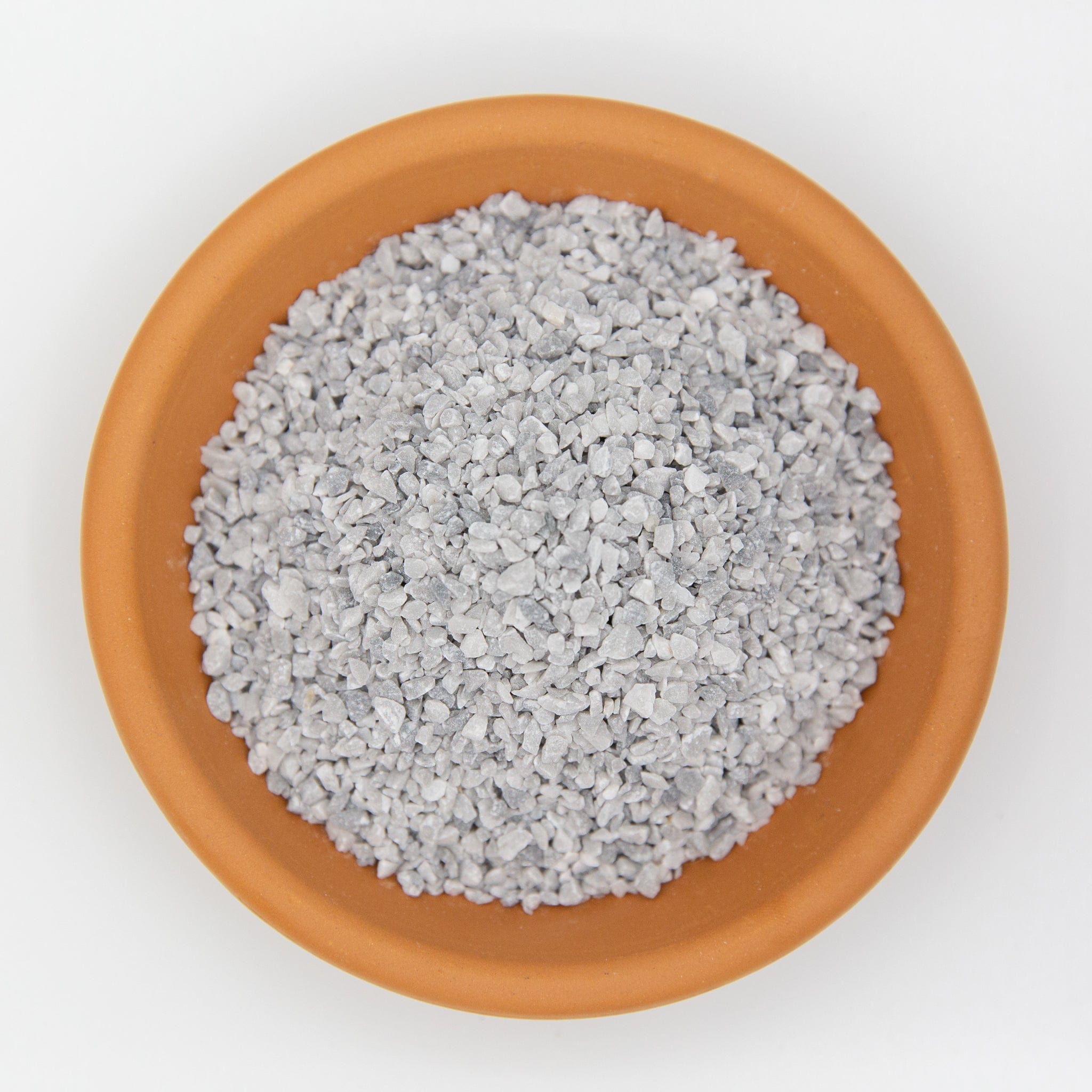Limestone chips are a valuable mineral addition for cactus and succulent growers, particularly those cultivating species from native limestone habitats.
Screened to a clean and uniform 1–5mm size, these chips provide a slow-release source of calcium carbonate while raising the pH of acidic soils to optimal levels for sensitive plant varieties.
This product enhances both nutrient availability and root health in mineral-rich, alkaline-loving species.
Features
-
Graded 1–5mm for consistent blending and distribution in soil.
-
Natural Calcium Carbonate Source: Boosts calcium levels in soil to support healthy plant cell development.
-
pH Buffering: Helps raise and stabilize soil pH, especially beneficial in acidic environments.
-
Cleaned for Immediate Use: No dust or debris, reducing mess and making mixing easier.
-
Ideal for Limestone-Adapted Plants: Perfect for plants that naturally thrive in high-pH, calcareous environments.
Why You Should Buy
For growers of specialized succulents and cacti, including many from limestone-rich regions, the soil’s pH and mineral balance are crucial for thriving growth. These premium limestone chips offer a precise way to modify your mix, delivering slow-releasing calcium and raising the pH to encourage nutrient absorption and prevent common root problems. Their clean, uniform grade ensures ease of use and optimal aeration without compacting your soil blend.
FAQs
What exactly are these Limestone Chips?
Uniform, cleaned 1–5 mm calcium carbonate (CaCO₃) chips designed for horticulture—especially cactus & succulent mixes—to supply slow-release calcium and gently raise acidic media toward neutral/alkaline.
What size are the chips?
They’re screened to a consistent 1–5 mm grade for easy blending and even distribution.
What plants are Limestone Chips best for?
Cacti and succulents from limestone/calcareous habitats, and other alkaline-leaning species that appreciate extra calcium and a slightly higher pH.
How much should I mix into potting media?
Use ~5%–25% of total mix volume depending on the plant and how calcareous you want the medium. Start at 5–10% for general use; go higher for true limestone specialists.
Can I top-dress instead of mixing?
Yes, but it’ll act slower than blending through the mix because coarse particles contact less soil solution per unit time. Finer lime works faster than coarse; lumps can take years to react.
How fast will these chips change pH?
They work gradually. Coarser CaCO₃ is far less soluble than hydrated/burnt lime, so expect a slow, steady shift over weeks to months, not days. (Calcium carbonate is ~100× less soluble than slaked/burnt lime.)
Will these improve drainage?
They won’t clog mixes—1–5 mm chips maintain porosity and air-filled pore space. That said, think of them as a mineral/calcium source and pH buffer first, not a perlite/pumice replacement.
Can I use Limestone Chips in general potting mixes?
You can, but they’re particularly useful where you actually want a higher pH and extra calcium (e.g., calcareous succulents, some bonsai). For acid-loving plants, skip lime entirely.
Are Limestone Chips suitable for bonsai?
Yes—especially for species that prefer slightly alkaline media or benefit from added calcium. Blend sparingly (5–10% to start).
I grow blueberries/camellias/azaleas—should I add Limestone Chips?
No. Those are ericaceous, lime-hating plants that require acidic media; adding limestone will push pH the wrong way.
How do chips compare to powdered “garden lime”?
Same chemistry, different speed. Powdered ground limestone (fine) reacts quicker and has a higher “effective neutralising value” than coarse chips. Use chips for controlled, slow buffering in pots; use finely ground ag lime for rapid soil correction in beds.
What’s the difference between limestone (garden lime) and dolomite?
Garden lime is mainly calcium carbonate; dolomite is calcium–magnesium carbonate and adds Mg too. Choose dolomite only if your soil/mix needs magnesium—otherwise plain limestone is fine.
Is hydrated/quicklime the same thing?
No. Hydrated (slaked) and quicklime act much faster, are more caustic, and aren’t recommended for potting mixes. Stick with calcium carbonate for safe, predictable pH buffering.
How much should I use in garden beds or lawns?
This product is coarse chips—great in pots, slower in ground. For beds/lawns where you want to change pH, use finely ground ag lime and calculate rates from a soil test (typical rates range higher for clays than sands). Government/industry guides and calculators are your friend here.
Do I need a soil pH test first?
Highly recommended. Lime is for acidic conditions—adding it to neutral/alkaline soil can lock out nutrients. Most plants are happiest ~pH 6–7 (exceptions apply).
Will adding limestone cure blossom end rot in tomatoes?
Not immediately. BER is a calcium-uptake issue usually driven by inconsistent moisture; improving calcium and pH helps long-term, but there’s no instant fix—keep watering consistent and manage overall nutrition.
Is Limestone Chips safe for use around pets and kids?
Calcium carbonate is generally low-hazard, but any dust can irritate eyes/airways. Keep pets and kids away during application, avoid creating dust, and store sealed and dry.
Can I use Limestone Chips in aquariums or drinking-water systems?
We don’t sell or certify this product for aquaria or potable-water treatment. While a customer mentioned using chips in a rainwater tank, that’s anecdotal—use purpose-made, certified calcite media if treating water.
Can I use these in hydroponics to adjust pH?
Not practically. Calcium carbonate dissolves very slowly and won’t give you controllable pH shifts in recirculating systems—use proper hydro pH adjusters instead. (CaCO₃ has extremely low solubility.)
Are Limestone Chips dusty?
They’re cleaned to reduce mess versus quarry grit, but any mineral can shed some fines. Open the bag gently and avoid dumping from height.
How do I combine Limestone Chips with other amendments?
Treat chips as your calcium + pH buffer; you can still use pumice/perlite for drainage and compost for biology. If you already add dolomitic lime elsewhere, be mindful of total Mg inputs.
What’s a sensible starting recipe for calcareous succulents?
Example: 50–60% mineral (pumice/scoria), 20–30% bark or coarse organics, 10–15% sand, and 5–15% limestone chips. Adjust after observing growth and your water source alkalinity.
Will limestone chips affect nutrient availability?
Raising pH in acidic media can improve availability of P & Mo and reduce Mn toxicity, while supplying exchangeable Ca—useful for many crops within the right pH window.
Do Limestone Chips help with hard, compacted clay?
Lime can aid structure over time in acidic clays by flocculating particles, but chips work slowly. For fast structural fixes, address organic matter and gypsum (for sodic clays) alongside appropriate lime if the soil is acidic.
Can I over-lime with chips? What are the signs?
Yes—excess lime can lock out iron/manganese and push pH too high. Watch for chlorosis (yellowing leaves with green veins) and stunting; back off and re-test pH.
How often should I reapply?
In pots: refresh when you repot or if pH drifts acidic again. In soils: fine ag lime applications can last years depending on rainfall, soil texture, and rate—chips act more slowly and last longer per application.
Can I use Limestone Chips as a decorative top layer?
You can, but understand they’ll still raise pH over time with watering. Avoid around acid-lovers and blue-hydrangea beds unless you want to push blooms toward pink.
Any handling/storage tips?
Store sealed, dry, and out of reach of kids/pets. Avoid breathing dust and wash hands after use—standard SDS hygiene.
Any quick rules of thumb before adding lime to a garden bed?
-
Test pH first.
-
If pH is low, use fine ag lime for bed corrections; chips are better in pots.
-
Rate depends on soil texture (clays need more than sands).
-
Don’t lime acid-loving plants.
Can I combine Limestone Chips with dolomite?
Only if you need magnesium; otherwise you risk pushing Mg too high relative to Ca. Check your soil or water test first.
Do Limestone Chips stain or fizz with acids?
All limestone reacts with acids (it’ll fizz), so keep away from acid treatments and surfaces that might etch.
Are these “food-grade”?
No—this is a horticultural product. Do not use for food or drinking-water contact applications.
Can I use Limestone Chips to raise aquarium pH/hardness?
Use aquarium-grade calcite/aragonite instead. Our chips aren’t certified for aquatic life or potable use, and dissolution is too slow to control pH precisely.
When’s the best time to lime outdoor beds?
For those choosing powdered lime outdoors, many guides suggest autumn so it can react over winter; chips will be slower regardless of season. Always base timing on a soil test and your crop.
What if I just want calcium without changing pH?
Use gypsum (calcium sulfate) instead of lime; it supplies Ca with minimal pH change compared to carbonates. (Note: gypsum is much more soluble than CaCO₃.)
What’s the neutralising value (NV) thing I hear about with lime?
NV compares acidity-neutralising strength to pure CaCO₃ (=100). Particle fineness and NV together determine how effective/fast a lime is in soil. Chips are coarse, so expect lower effective neutralising action per unit time than fine lime.
Any reason not to use Limestone Chips?
Avoid in mixes for acid-lovers; don’t use for rapid pH fixes; and don’t use it for potable water/aquarium systems. If you already have alkaline tap water or a calcareous base mix, consider starting at the low end (5%) or skipping entirely.


